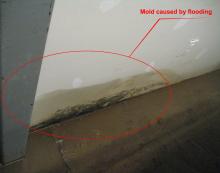Mold Assessment and Remediation Guidelines
April 2022
Basic Mold Information
Mold can be found almost everywhere, inside and outside of buildings, in air handlers and on many types of surfaces. It has the potential to develop wherever moisture is present, including, but not limited to cardboard, fabric, organic material, paper, soil and wood. It is transferred from one place to another by air movement, ventilation systems, vibration and wind. Dark, humid/moist conditions will encourage mold.
There are several genus and species of mold, some are common and more of a visual nuisance, while others are considered hazardous to your health, especially if the person has allergies, lung related illnesses, or are immuno-compromised.
“Black mold” could be a type of mold known as Stachybotrys, which does not typically grow on wood, spreads slowly and is considered toxic. Many types of mold can appear black and are considered low hazard. The only way to determine what type of mold is present is to test it.
As long as surfaces have the appropriate nutrients (materials with carbon and nitrogen) as well as moisture, mold spores will continue to amplify.
Mold spores can enter a building attached to a person or pets, through doors, heating and air conditioning systems, vents and windows. It is often found around pipe and roof leaks, in bathrooms and basements and on windows, possibly resulting from condensation. When building materials and other items become damp or wet, and are not correctly addressed, mold is likely to develop. Mold is often found inside a building on boxes, cardboard, ceiling tiles, dust, fabric, paints, sheet-rock, upholstery, wallpaper and wood. Unfortunately, what can be seen may be only be a small percentage of the problem. What grows behind the wall because it’s wet and dark, may be the more significant issue at hand.
Health Effects
For many people, mold is a significant concern. For those who are sensitive to its presence, it may trigger an asthma attack or initiate an allergic reaction. It can instigate coughing, eye irritation (itchy and watering), nasal stuffiness, throat irritation and/or skin discomfort. People who are immuno-compromised could develop a serious lung infection that may be difficult, if not impossible to treat.
Amherst College Moisture and Mold Remediation Response
Amherst College faculty, staff, students and visitors should always report the following non-emergency conditions to the Amherst College Facilities Department (413) 542-2254 or by e-mail at servicectr@amherst.edu.
1. Water damage and leaks regardless of cause or potential source, both inside and outside the building

2. Any drain or sewer related issues
3. Decaying leaves, mulch or similar outside organic material outside of buildings around doors, windows and ventilation systems
4. Standing water within 10’ of the building
If the above referenced condition is an emergency, such as a broken or leaking pipe, and it occurs after hours, (3:30pm – 7:00am or on the weekend) contact the Amherst College Campus Police at (413) 542-2291.
Amherst College will initiate the most appropriate response, depending on the type of emergency. The process, although it may change slightly, depending on the cause typically follows this procedure;
a) Stop the source of the moisture or water problem, such as a pipe or roof leak
b) Begin the drying process by utilizing dehumidification, not fans
c) Remove all affected mold supporting building materials and other wet items
§ Clean items that can be washed and thoroughly dried, if appropriate
§ Dispose of building materials including sheet-rock and insulation, as well as items that cannot be appropriately cleaned, washed or decontaminated.
d) Clean all surfaces that can be aggressively washed using the appropriate bleach and water solution or other EPA approved disinfectant, specifically identified for mildew and mold.
e) Verify that all areas are completely dry
f) After remediation is complete, replace building materials in accordance with Facility guidelines.